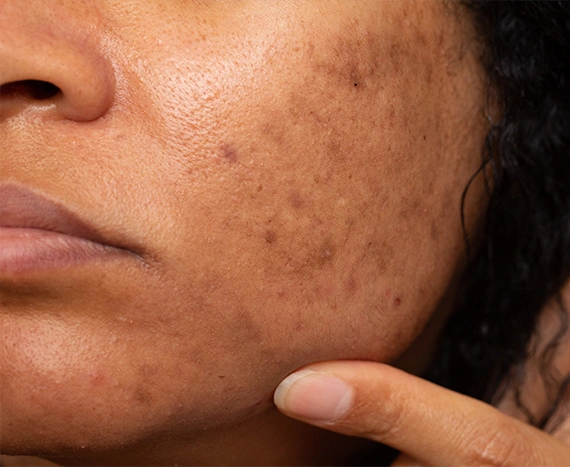
Hyperpigmentation
Simply put, it’s an overproduction of melanin, the substance that gives our skin, hair and eyes their color, in a concentrated area. If you have freckles on your face, you have hyperpigmentation. However, for some people, the condition causes large splotches of dark coloring in the skin of their faces, hands or other parts of the body.
While hyperpigmentation doesn’t carry any serious health risks, it can be a source of embarrassment, and can have a detrimental effect on a person’s confidence and self-esteem.
Hyperpigmentation Types
A few different types of hyperpigmentation exist. Knowing which one is affecting you can help determine the appropriate treatment for it.
Melasma
This is a common type of hyperpigmentation, often caused by too much sun exposure over a period of years. It consists of irregular skin coloring, most often brown, but sometimes gray. Melasma usually appears as blotches with uneven borders on the face, most often on the cheeks, forehead, chin, bridge of the nose, and even the upper lip. It can also occur on the forearms and neck. Essentially, any place on the body that gets regular, consistent sun exposure is at risk for developing melasma.
One of the difficulties with melasma is that because the splotches can sometimes be so dark, makeup is often not enough to cover it.
Chloasma
This condition manifests in exactly the same way melasma does—irregularly shaped, dark patches on the face, and possibly elsewhere on the body. The difference is chloasma is usually a temporary condition brought on most often by pregnancy. For this reason, it’s often referred to as “the mask of pregnancy.”
This is also true of melasma, which is also thought to be caused by hormonal changes. But while chloasma usually dissipates after childbirth, melasma most often requires some sort of treatment to even out the skin tone.
Because it’s associated with hormonal changes, women taking birth control pills or hormone replacement therapy may also sometimes develop chloasma.
Hyperpigmentation Prevention
The number one way to avoid any type of hyperpigmentation is to use sunscreen every time you go outside, even if you’ll only be in the sun for a short amount of time. Because chloasma (and in some cases, melasma) is also caused by hormonal fluctuations, you may still develop it even if you use sunscreen, particularly during pregnancy.
If you’ve already developed hyperpigmentation or melasma, don’t despair. You can pursue treatment to get your even, unblemished skin back.
Age Spots
You may have also heard them referred to as “liver spots.” Most often age spots appear on the backs of our hands as we age, but they can also develop on the shoulders, arms and face—again, areas of the body most often exposed to the sun. Age spots are most common in people over 50, but younger people can get them too, especially if they spend a lot of time in the sun.
Hyperpigmentation and Melasma Treatment
Here at Artes Radiance, we use the Laser, Advanced Whitening Peel and other chemical peels to treat melasma and all types of hyperpigmentation.Nd:YAG laser, the same kind used in both laser hair removal and laser tattoo removal. This type of laser is used for these purposes for two main reasons: it’s gentle, and doesn’t damage the skin; and it targets multiple shades of color simultaneously. It’s this ability that makes it such an effective treatment for melasma and hyperpigmentation.
In addition to hyperpigmentation and melasma, the laser may also treat some birthmarks and freckles. If you have either of these concerns, be sure to bring them up during your consultation.
Advanced Whitening Peel
The Depigmentation Peel is a unique, multi-ingredient chemical treatment designed to reduce areas of skin discoloration and hyperpigmentation. Melanin is responsible for creating the skin tone, as well as splotchy areas of darker tissue. The Advanced Whitening Peel decreases the skin’s natural melanin production by inhibiting certain enzymes, providing an even complexion.
Advanced Whitening Peel can be used to improve the look of facial skin, the abdomen, legs/hands, and the breast/nipple area. Dull skin, dry areas, dark spots, blemishes, and acne scars can be significantly reduced with the peel. Discoloration due to Melasma (Brown to gray patches over the bridge of the nose, cheeks, chin, and elsewhere on the face and body; often the result of hormonal changes) and Cholasma (similar to Melasma; referred to as the Mask of Pregnancy) can be eliminated with the Advanced Whitening Peel. In addition, the peel balances the skin’s oil production to improve acne.
Nd:yag Laser
The skin discoloration is targeted by the Nd:YAG laser beam. The light is absorbed by the melanin, which helps to break the excess pigmentation up into smaller particles, effectively destroying the discoloration. Usually, all traces of hyperpigmentation are removed, leaving behind uniform, even skin tone. The particles of melanin are simply absorbed by the body with no detrimental effects.
This treatment is so effective that many patients see improvement after just one session of hyperpigmentation treatment. However, please note that more than one session may be required to achieve optimal results.
